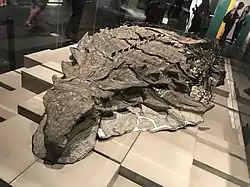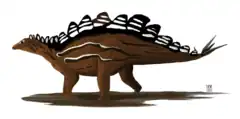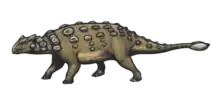Nodosaurinae
Nodosaurinae is a subfamily of nodosaurid ankylosaurs from the Cretaceous of Europe, North America, and South America. The group is defined as the largest clade containing Nodosaurus textilis but not Hylaeosaurus armatus, Mymoorapelta maysi, or Polacanthus foxii, and was formally named in 2021 by Madzia and colleagues, who utilized the name of Othenio Abel in 1919, who created the term to unite Ankylosaurus, Hierosaurus and Stegopelta.[1][2] The name has been significantly refined in content since Abel first used it to unite all quadrupedal, plate-armoured ornithischians,[2] now including a significant number of taxa from the Early Cretaceous through Maastrichtian of Europe, North America, and Argentina. Previous informal definitions of the group described the clade as all taxa closer to Panoplosaurus, or Panoplosaurus and Nodosaurus, than to the early ankylosaurs Sarcolestes, Hylaeosaurus, Mymoorapelta or Polacanthus, which was reflected in the specifiers chosen by Madzia et al. when formalizing the clade following the PhyloCode. The 2018 phylogenetic analysis of Rivera-Sylva and colleagues was used as the primary reference for Panoplosaurini by Madzia et al., in addition to the supplemental analyses of Thompson et al. (2012), Arbour and Currie (2016), Arbour et al. (2016), and Brown et al. (2017).[1][3][4][5][6][7]
| Nodosauridae |
| |||||||||||||||||||||||||||||||||||||||||||||||||||||||||||||||||||||||||||||||||||||||||||||||||||||||||||||||||||||||||||||||||||||||||||||||||||||||||
| Nodosaurines Temporal range: Cretaceous, | |
|---|---|
 | |
| Fossil of Borealopelta | |
| Scientific classification | |
| Domain: | Eukaryota |
| Kingdom: | Animalia |
| Phylum: | Chordata |
| Clade: | Dinosauria |
| Clade: | †Ornithischia |
| Clade: | †Thyreophora |
| Suborder: | †Ankylosauria |
| Family: | †Nodosauridae |
| Subfamily: | †Nodosaurinae Abel, 1919 |
| Subgroups[1] | |
References
- Madzia, D.; Arbour, V.M.; Boyd, C.A.; Farke, A.A.; Cruzado-Caballero, P.; Evans, D.C. (2021). "The phylogenetic nomenclature of ornithischian dinosaurs". PeerJ. 9: e12362. doi:10.7717/peerj.12362. PMC 8667728. PMID 34966571. S2CID 245111393.
- Abel, O.L.F.A.L. (1919). "Die Stämme der Wirbeltiere" (in German). Berlin und Leipzig: Walter de Gruyter. doi:10.5962/bhl.title.2114.
{{cite journal}}: Cite journal requires|journal=(help) - Thompson, R.S.; Parish, J.C.; Maidment, S.C.R.; Barrett, P.M. (2012). "Phylogeny of the ankylosaurian dinosaurs (Ornithischia: Thyreophora)". Journal of Systematic Palaeontology. 10 (2): 301–312. doi:10.1080/14772019.2011.569091. S2CID 86002282.
- Arbour, V.M.; Currie, P.J. (2016). "Systematics, phylogeny and palaeobiogeography of the ankylosaurid dinosaurs". Journal of Systematic Palaeontology. 14 (5): 385–444. doi:10.1080/14772019.2015.1059985. S2CID 214625754.
- Rivera-Sylva, H.E.; Frey, E.; Stinnesbeck, W.; Carbot-Chanona, G.; Sanchez-Uribe, I.E.; Guzmán-Gutiérrez, J.R. (2018). "Paleodiversity of Late Cretaceous Ankylosauria from Mexico and their phylogenetic significance". Swiss Journal of Palaeontology. 137: 83–93. doi:10.1007/s13358-018-0153-1. S2CID 134924657.
- Arbour, V.M.; Zanno, L.E.; Gates, T. (2016). "Ankylosaurian dinosaur palaeoenvironmental associations were influenced by extirpation, sea-level fluctuation, and geodispersal". Palaeogeography, Palaeoclimatology, Palaeoecology. 449: 289–299. Bibcode:2016PPP...449..289A. doi:10.1016/j.palaeo.2016.02.033.
- Brown, C.M.; Henderson, D.M.; Vinther, J.; Fletcher, I.; Sistiaga, A.; Herrera, J.; Summons, R.E. (2017). "An Exceptionally Preserved Three-Dimensional Armored Dinosaur Reveals Insights into Coloration and Cretaceous Predator-Prey Dynamics". Current Biology. 27 (16): 2514–2521. doi:10.1016/j.cub.2017.06.071. PMID 28781051. S2CID 5182644.

